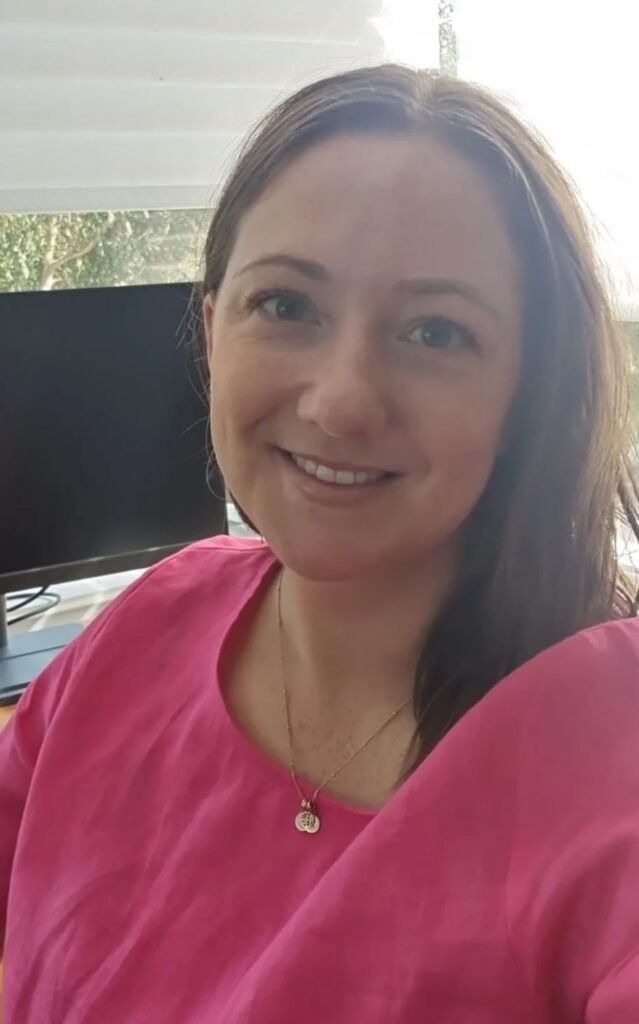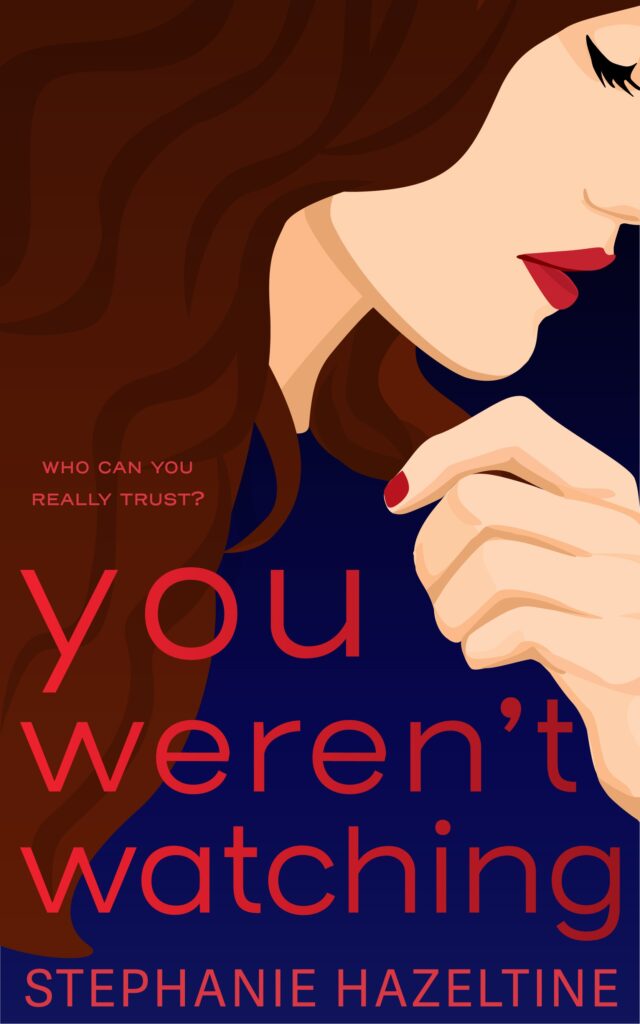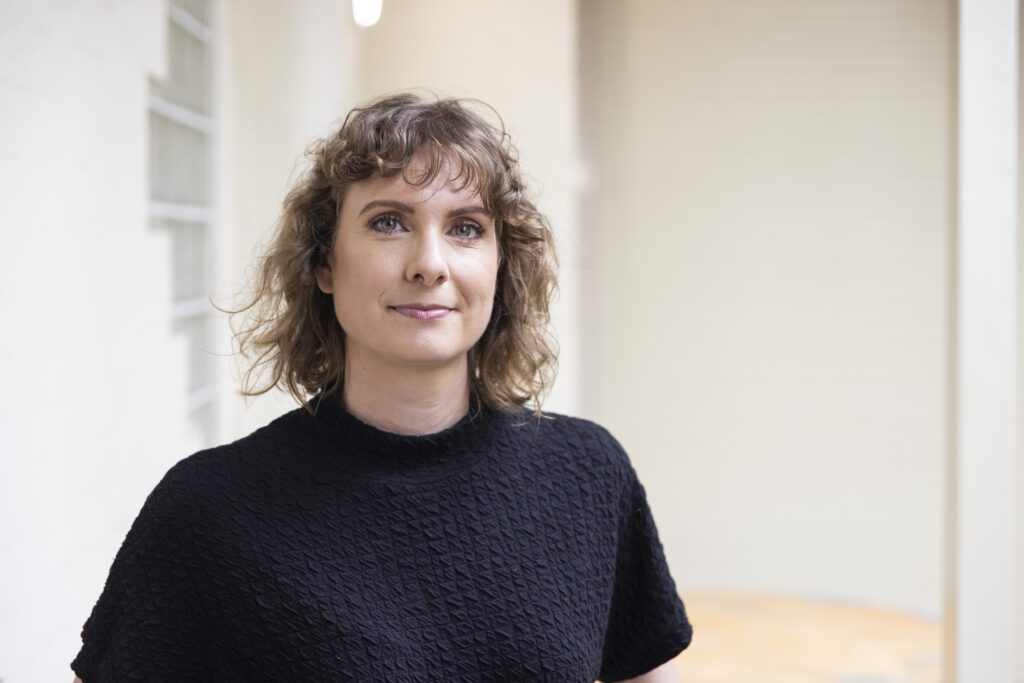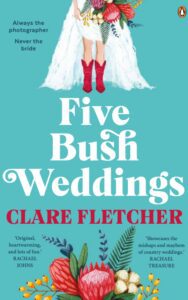Samantha L. Valentine is writing it like it is
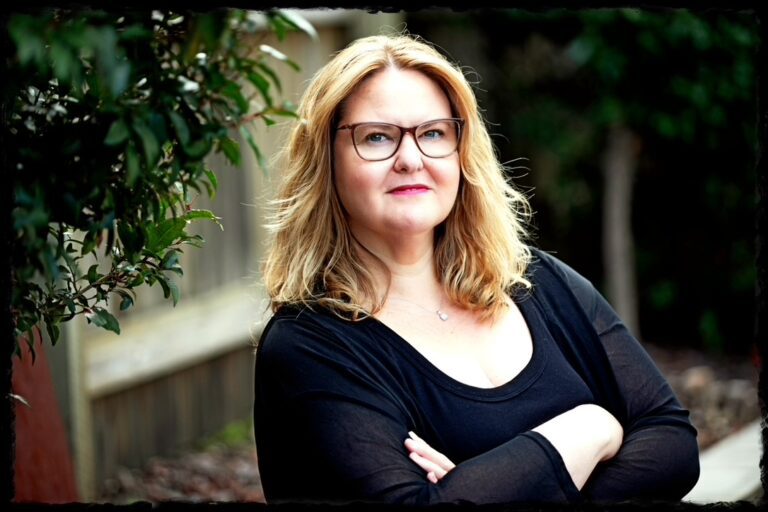
The Meet Me in Berlin author on why realism is essential for a great romance.
It’s the most romantic premise: two lovers from opposite sides of the globe vow to meet in the same place at the same time every year if they should ever lose one another. It’s also pretty unrealistic, which is why Sam Valentine says she made sure the rest of her new novel, Meet Me in Berlin, was unflinchingly true to life. In this contemporary romance, Casey, a British art curator, and Holly, an Australian photographer, grapple with grief, infidelity and heartbreak on their way to their HEA.
That’s not to say Meet Me in Berlin is a heavy read – it’s balanced with plenty of laughter and spice too, which made working on the copy-edit earlier this year a real joy for me.
This is Sam’s second novel – her first, Normal Functioning Adult, has just been re-released under her own publishing company – and her work has also been featured in the Romance Writers Australia Sweet Treats anthology. As Meet Me in Berlin hits shelves, I asked Sam to share her thoughts about writing realistic characters in romance, the diversity missing from Australian fiction, and why she recently made the switch from hybrid to indie publishing.
This is a long read but a really juicy one as we explore some topical issues – grab a cuppa, settle in and enjoy!
Sam, it was so lovely to to work with you on Meet Me in Berlin. Can you share the story behind this book? What inspired it?
It was mid-March 2022 when I first had the idea for this book, which came overnight! I wasn’t sure what was happening with Normal Functioning Adult (my first novel), and I was a bit down about receiving yet another rejection. A writer I was friendly with at the time had just started indie publishing short romances and suggested putting NFA to the side and trying something else – maybe writing a romance to indie publish. Immediately, I grabbed a notebook and googled Shakespeare plays for plot inspiration. Somehow The Comedy of Errors gave me the idea (I think it was the accidental meeting after a lifetime apart bit) of two people meeting, losing touch and looking for one another years later in a foreign city. I think the wedding shambles from Much Ado About Nothing gave me the idea of someone running from a wedding. The following day in my lunchbreak at work, I combined those ideas, scribbled out a basic plot and started writing that night. Ten days later, I had a very rough 38,000-word draft and it grew from there, taking a good year or so to complete.
Other than getting the initial idea from a couple of Shakespeare plays, the events of the novel really weren’t inspired by anyone or anything – it’s all fiction – but the idea of ‘if we lose each other then we’ll return to this spot, on this day, at this time every year until we find each other’ was so unrealistic to me (yes, my own idea was unrealistic to me), I was inspired to make the rest of the novel as true to life as I could to make that concept believable.
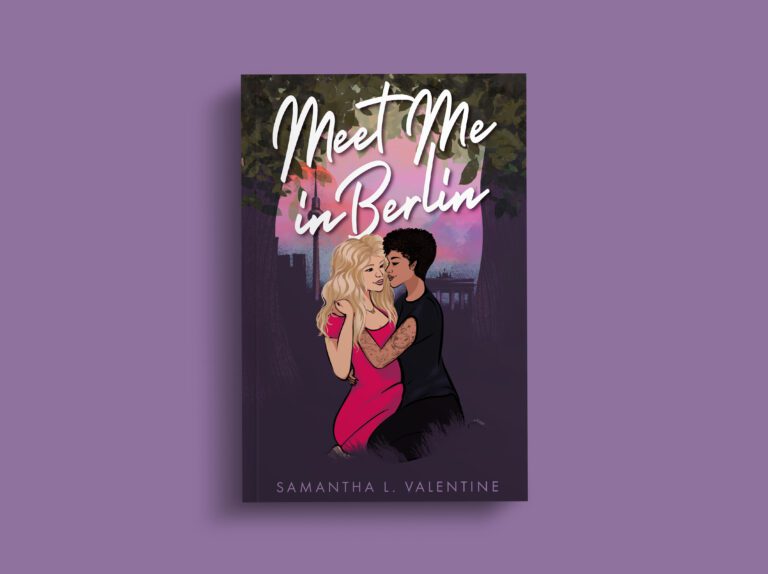
Both your lead characters work in the art world and there are a couple of paintings that become meaningful for Holly and Casey. What role does art play in your life?
Art and photography (how they feature in the novel) don’t play much of a role in my life at all. My wife is quite a good artist (drawing and painting), and we’ll go to exhibitions now and then, but I really don’t know a lot about paintings or the art scene, and I know even less about photography.
I stumbled upon Italia und Germania and Sappho and Erinna (the paintings referenced in the novel) when I was looking for art that suited the plot and characters, and I thought both worked well with the storyline, so I found ways to work them in. I also discovered a UK art podcast called The Week in Art, which I listened to every week while I was writing the novel, and I found a good photography podcast too. I still listen to the art podcast each week – it’s my comfort listen when I’m grocery shopping. I also love that my cover designer (who reads every novel she designs a cover for) modelled the illustration of Holly and Casey on the Sappho and Erinna painting and a scene in the book where they take a photo of themselves in a similar embrace.
What did you find most fun or interesting about writing Meet Me in Berlin?
It was a fun novel to write! Revisiting London and Berlin (virtually) was great, particularly London as I lived there for eight years and have such fond memories of that time. I even snuck in a street reference where I lived for a few years (Cruden Street in Angel). It was also fun to write a character like Casey who is very different from me – a mixed-race woman from East London. I did quite a bit of research to write Casey, which was interesting and insightful, particularly a book I read called Biracial Britain by Remi Adekoya. I liked writing British characters in general, too, as I did my linguistics degree in London and studied British English and English dialects, and my wife is British (not from London) so she likes that the novel features British characters. Making a silly concept like ‘if we lose each other, then we’ll come back to this spot, on this day, at this time, until we find each other’ realistic was also fun (and a bit challenging).
I loved the way both characters deal with quite difficult circumstances and you don’t shy away from depicting morally grey actions, which we don’t always see in romance. I think it’s a great way to illustrate the growth of your characters. What made you want to lean into a realistic take rather than an idealised one?
I’m not sure it was a case of wanting to – it’s just my style as a storyteller. I generally always write stories with a realistic take, but they’ll also have sprinklings of idealism, or at least convenient plot events to give a story a happier spin. Maybe that comes from growing up on fairytales, which are fantastic for conflict, flawed and morally grey characters, villains, dark themes, but also happy endings, satisfying character growth and positive coincidences. I’m a fairly down-to-earth, authentic and practical person and this probably comes through in my writing. That doesn’t mean I am my characters, of course, far from it, and I intentionally work hard to make my characters very different to me (my stories would be very boring if they were based on my life and I only wrote what I knew). So flawed characters who make questionable decisions (not necessarily always morally grey) will likely feature in all of my longer stories (maybe even my short stories, too — my RWA Sweet Treats anthology story certainly isn’t idealised and it will hopefully stand out for that reason).
Obviously there’s nothing wrong with idealised romances if that’s what people enjoy reading or authors like to write, but to me, fiction is an art form and art reflects society. Do we live in an idealised society? No. Is love and romance always idealistic, perfect and puritan? No. At its core, romance is about relationships, so it makes sense that it would contain realistic elements involving human actions and emotions. Humans are messy and flawed, their actions often a result of deep-seated wounds or their life experiences. Love and relationships can be complex and complicated. So why not show all of this in fiction as a depiction of contemporary life? That said, at the same time, novels are also great for escapism and relaxation and getting lost in other worlds, and this is where adding those idealistic elements, like happy endings or coincidences that wouldn’t actually happen in real life can help.
Love and relationships can be complex and complicated. So why not show all of this in fiction as a depiction of contemporary life?
It’s interesting to me that there’s often this expectation in contemporary fiction, mainly women’s fiction and romance, that novels mirror modern society in terms of what characters do, say and think, but when a book has flawed, morally grey characters and actions that would actually happen in the real world, it’s often not well received. That seems very contradictory to me. I’ve even had a beta reader of another story tell me my character couldn’t think something because they were judging another character! To have a character only act and even think in a certain way is preposterous.
So far, I’ve received some really great reviews and feedback for Meet Me in Berlin, which is wonderful, and quite a few readers have commented how much they like the flawed characters. So I think generally readers do like reading about conflict and complicated actions. However, I’ve also received some not-so-great reviews, which is fine, that doesn’t bother me so much, and readers can dislike books and review however they want. But the content of some of these reviews has surprised me, which ties into the idealised view of romance books and morally grey characters.
In the case of Berlin, this relates to infidelity. Firstly, novels aren’t manuals for life. It’s not a novelist’s job to set the world to rights with their stories. Stories need conflict and how the plot unfolded around this topic in Berlin created the perfect conflict, both external and internal. Secondly, the way it pans out is very realistic. So many people become unhappy in relationships, even when they’re about to get married, but don’t know how to leave and end up doing something stupid as a way to get out of the relationship. People also fall for other people when they’re in relationships – it happens! Is it a hurtful, shitty thing to do? Of course it is, but I wasn’t going to turn my fictional story into a non-fiction moral compass on fidelity – who am I to tell people how to manage their relationships? I’m an author making up stories – the characters aren’t me and their story isn’t mine. I’ll also say that I’m purely talking about character flaws and morally grey actions here; I don’t think filling a book with hateful content or behaviours towards certain groups for no reason under the guise of fiction is okay.
You’ve also said you want the world to read more diverse Australian stories. Why is that important and what do you think is missing from Australian literature?
I don’t believe Australian fiction is nearly as diverse as people like to think it is, and I’m not sure it’s improving much either. I’ll focus on the Australian lesbian/sapphic space because that’s my area. I could count on one hand (maybe two) the traditionally published adult lesbian/sapphic novels that have been produced in this country in the past few years. There has been a small increase in lesbian/sapphic romances (of varying subgenres) overseas, and there are some Australian own voices authors with international publishers, mostly romance authors as well. But sapphic women are more than coming-out stories (which is often a YA story) and romance!
I see Australian agents and publishers seeking ‘diversity’, yet their actions don’t appear to support a lot of diverse fiction, because in reality, it’s about business and markets.
I also don’t like this notion that queer stories have to be happy ones (like YA and idealised romance). Queer women do all the things heterosexual women do – they work, get divorced, have families, grieve, have addictions, lose people, take drugs, have mental health issues, struggle with life, have affairs, get into debt and so forth, so where are these stories with lesbian characters? They’re certainly not being published by Australian publishers and I doubt it’s because they’re not being written.
Both Normal Functioning Adult and Meet Me in Berlin were taken seriously by big five publishers, but NFA was turned down because they didn’t know how to market it (it’s just women’s fiction but features gay women – it couldn’t be marketed alongside other women’s fiction?) and Berlin was turned down despite the publisher loving the book because apparently the market is saturated with rom-com type novels (although it’s hardly saturated with Australian sapphic rom-coms) and retailers only want the big-name authors at the moment, i.e., authors big on BookTok. So Australian publishers and agents can scream diversity all they want but at the end of the day it doesn’t trump markets, and until it does, we won’t see an increase in Australian traditionally published diverse fiction.
Sapphic women are more than coming-out stories and romance!
This is why indie publishing is popular for lesbian and sapphic fiction, because it really is the only option for so many of us. I also see a lot of people saying ‘it’s better than it was’ or ‘there’s loads of LGBTQ books now’ because queer YA is becoming more popular globally, which is great, but YA is just one genre and it’s very different to adult lesbian fiction, so it’s frustrating when people lump the entire community into one basket. Also, so many people get their books from walking into bookshops, Big W or the library. They won’t find indie published or small press digital-only books in there, so they’ll continue to never know such stories exist.
I also see a lot of binaries in fiction – books are gay or straight, black or white, male or female, there’s very little middle ground. Something that hasn’t yet been picked up in Meet Me in Berlin by any reader and that was intentional on my part, is the blurred binary theme running through the novel – Casey is biracial, Holly is bisexual, and Dante (the wedding planner) is non-binary. Something small, but it was me saying not all fiction has to fit into a binary.
Let’s talk about the publication journey. Your first novel, Normal Functioning Adult, was with hybrid publisher Shawline, but you’ve since switched to indie publishing. Was working with a hybrid publisher a good training-wheels step?
Yes, I think so. At the time of deciding to go down this path, thinking about indie publishing and doing all the things I knew I’d have to do to get a book out there was too much for me to get my head around. I knew the costs involved in getting an editor, cover designer etc., and the time it would take me to indie publish, so I went with a hybrid because the outlay was about the same. While it didn’t end up being the right path for me, it gave me the opportunity to get my novel out into the world, build an author platform, learn more about publishing contracts and processes, meet some new authors, and I made a great friend (another Shawline author) that I am so grateful is in my life now.
Also, the timing of everything worked out well because I was able to align the republication of Normal Functioning Adult with the release of Meet Me in Berlin meaning I could use the same cover designer, which has been great for branding, and I created a business name to publish under so I was able to coordinate this across the two novels and get the same designer to create publishing logos for me, which appear on the spine and in the front of the both books.
So I feel like the way it all worked out was all meant to be!
What are the upsides to indie publishing?
Being able to source my own cover designer, editors, proofreaders, and set my own release dates has been great. I’ve also really liked being able to do my own typesetting and being able to update my manuscript so easily if there’s an error or issue. Higher royalties are also an advantage.
What do you find challenging? Do you have any advice you can share with other authors?
Indie publishing has been challenging because there is so much to do, and just getting my head around all the things has blown my mind a bit! Although getting two full length novels ready to indie publish at the same time was a bit full on – I don’t recommend doing that. Dealing with Ingram Spark, Amazon etc has been tricky. My advice for those who’d like to indie publish is to set yourself a release date that gives you plenty of time to do everything you need to do. Then start looking into indie publishing, the different options and platforms, make yourself a plan and away you go. Think about editors and cover designers ahead of time because the good ones are often booked up months in advance. If you have a Mac, invest in Vellum (typesetting software) because it will save you a stack of money in typesetting fees (I bought it at a reduced price on Cyber Monday). There’s also quite a few good indie publishing Facebook groups and look at other indie authors to see what they’re doing.
What’s your experience of the editing process like, having been through it a few times now for your books?
So far I’ve had good experiences with editors, so I’ve been lucky, and I enjoy sending my stories out for editing feedback. I’m okay at editing my own stories, too, since I did editing in my Master’s, and I also did the Cut, Shape and Polish course through Australian Writers Centre, which I found really helpful for reviewing my own novels. But there’s always a layer of subjectivity when self-editing so I like to send my work out to someone else to edit.
My advice for those who’d like to indie publish is to set yourself a release date that gives you plenty of time to do everything you need to do.
Can you share any insights or aha moments that came to you during the editing process?
For the developmental edit I had for Meet Me in Berlin, it was interesting to have another person’s view of the characters and plot because often editors will see what the authors can’t. Sophia, my developmental editor, gave some great recommendations to shape the novel, and I changed quite a few scenes from that edit. It was also interesting to have a different perspective on the characters. The description that is in the blurb about Casey, that she ‘works hard, plays hard and loves hard’ comes straight from Sophia. Although I’d spent a year writing Casey before sending the novel out for edit, I had never thought of her in those terms, but it was the perfect description for that character.
Your copy-edit was also an eye-opener because I had no idea how much I used certain words and action beats, and there were so many sentences that I wasn’t happy with, but I’d read the novel that many times it got to the point where I just couldn’t think of alternative phrases or words, so the copy-edit really helped with that. And picking up my Terry’s Chocolate Orange error was brilliant! [Note: A helpful thing that editors can offer is fact-checking! In this instance I double-checked a reference to this chocolate’s packaging and corrected the colour of the wrapper for Sam.]
What stage of editing do you find most helpful?
I find them all really helpful. A structural edit is great, but it often results in a stack of rewriting and reworking characters and plot! Copy-edits are great because you feel like you’re closer to finalising and it helps clean up all those clunky sentences and repetitions. Proofing is also good because by that stage you’ve read your own novel that many times that you think there couldn’t possibly be any mistakes, but there always is and I’m always interested to see what my own eyes missed.
I know you work full-time, so fitting writing in must be tricky! How do you stay on track with your writing goals?
I certainly had to give things up in order to write, like TV. Other than the news and a few shows here and there, I barely watch TV anymore and that gives me a lot of more time to do writerly things. To fit it all in around my day job, I mostly write/do author stuff in my lunch breaks (it’s amazing how much you can get done in a 45-minute lunch break if you focus), evenings, weekends and holidays. I don’t much else in my spare time – I hang out with my wife and dogs and see family and friends, but otherwise I’m usually doing author stuff of some description.
After a big push to release two books this year, what’s next for you?
I have a few stories sitting there I’m planning to get back to. I’m starting with a short story I wrote last year that I’d like to extend into a longer short story and publish as a digital-only release, possibly for Sapphic September. It’s a light-hearted, fun, contemporary romance (at this stage anyway, that could change!). I’d say it’s a fish-out-of-water trope.
Finally, Sam, what would you like your books to be known for?
I like the idea of my books being known for something that’s just a little bit different, like romance that has a bit of edge and grit, or engaging women’s fiction that features diverse characters. Regardless of the genre, I definitely would like my books to be known for being authentic stories with real-life themes and storylines that feature flawed, realistic characters.
Find Sam’s books and sign up for her monthly newsletter via her website. You can follow Sam on Instagram, TikTok, Facebook, Goodreads and Amazon.

